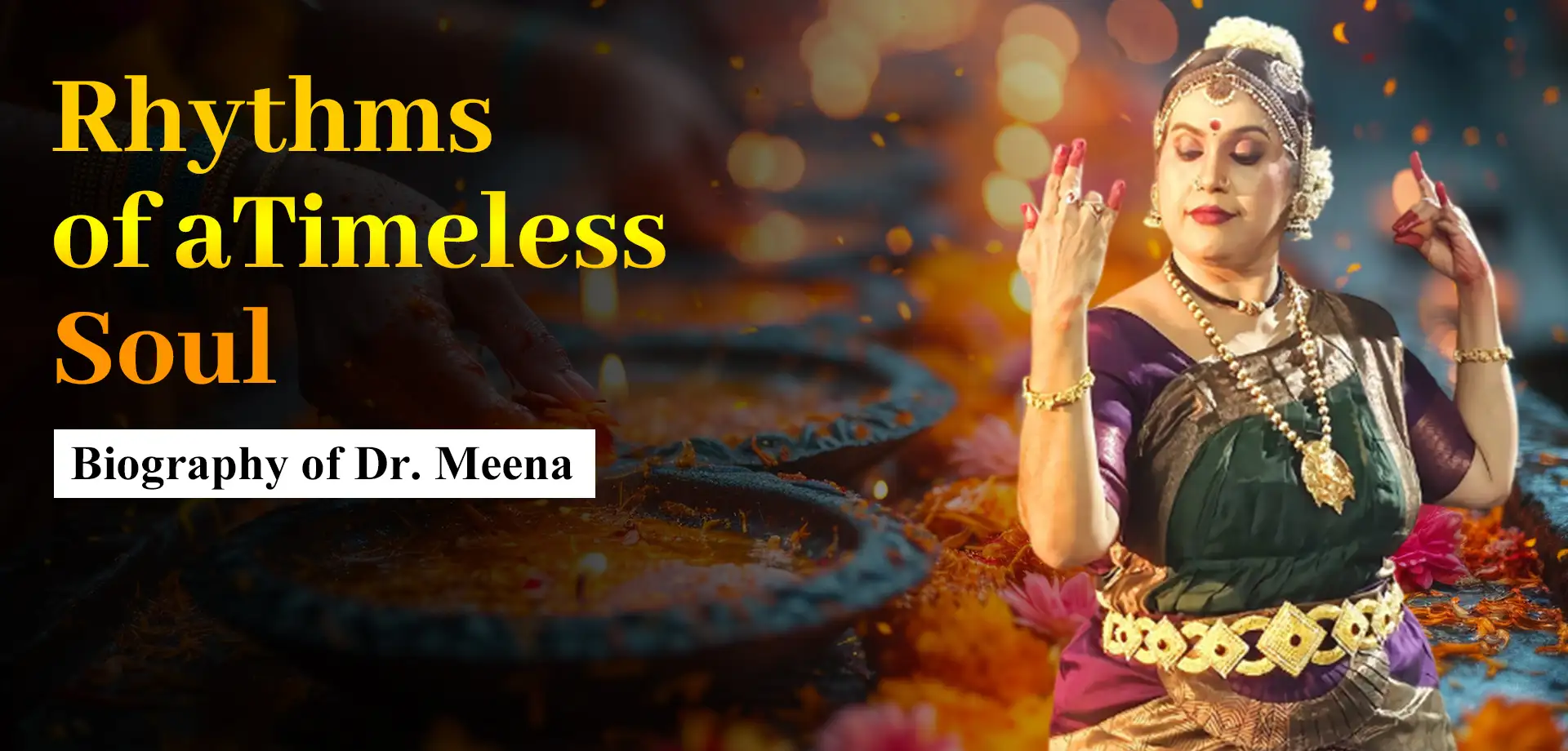
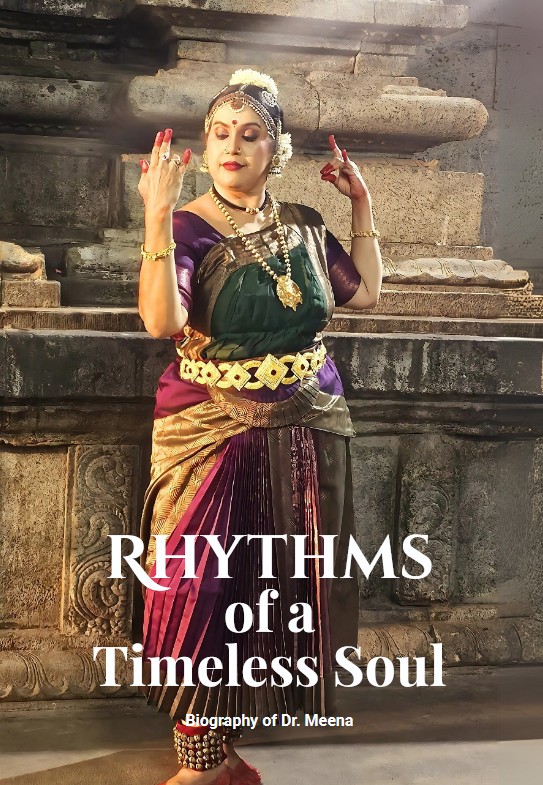
“Art enables us to find ourselves and lose ourselves at the same time.”
Introduction
In a world rushing forward with digital speed and fleeting trends, there are a few souls who choose to pause, to bow down to tradition, and to carry its lamp through the corridors of time. Dr. Meena Anilkumar is one such remarkable individual—a classical dancer, a devoted teacher, a cultural visionary, and a relentless preserver of India’s artistic heritage.
Her journey began not on a grand stage, but in the quiet corners of a dance classroom, where a four-year-old girl first discovered the magic of movement. That girl, trained initially under Kalamandalam Chandrika, would go on to master the intricate expressions and divine discipline of Bharatanatyam and Mohiniyattam under the tutelage of some of the finest gurus in the country. Her learning was not limited to technique—it was rooted in philosophy, history, and devotion.
Armed with dual postgraduate degrees in Economics and Bharatanatyam, Dr. Meena Anilkumar chose a path that was both artistically rich and socially significant. Her performances became meditations in motion; her classrooms, sanctuaries of culture. From the vibrant stages of Kerala, Dubai, and Qatar, to the budding aspirations of students across Europe and the USA, she nurtured not just dancers, but torchbearers of tradition.
Yet, Dr. Meena Anilkumar’s story extends beyond the dance floor. As a co-founder of the Indian Cultural and Heritage Centre (ICHC) in Kochi, Kerala, she channelled her vision into an institution that is now shaping the future of Indian classical arts. Guided by the wisdom of her father, Dr. K.K.N. Kurup, a renowned historian and former Vice-Chancellor of Calicut University, the ICHC stands as a living testament to cultural continuity.
She is not only a revered guru, but also a filmmaker, a choreographer, a national award recipient, and a global cultural ambassador. Every step in her journey has been a blend of tradition and transformation, discipline and creativity, rootedness and reach.
This biography is a tribute to that brilliant life—to the rhythms she has revived, the souls she has inspired, and the heritage she continues to uphold with grace and fire. It is not just the chronicle of a dancer, but the unfolding of a life devoted to something greater than the self—a life devoted to Nritya, to Sanskriti, to Bharat.
Phase 1 : The Awakening Rhythm
“Music gives a soul to the universe, wings to the mind, flight to the imagination, and life to everything.”
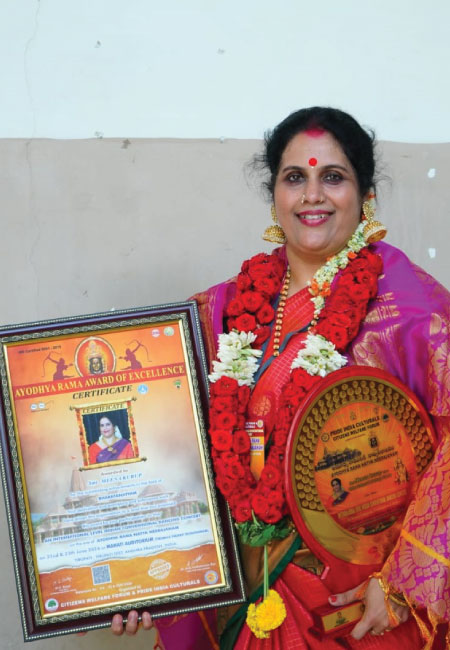
In the lush green heartland of Kerala, where monsoon rains hum ragas and temple walls echo with the chants of ancient mantras, a child’s destiny was being silently sculpted. The place was serene—where every breeze carried the scent of heritage, and every sunrise seemed to dance through the palms. Amid this cradle of culture, little Meena found her first language—not through words, but through movement.
She was only four when it began—not the usual age to awaken to one’s life purpose, but then again, Dr. Meena was never meant to be ordinary. While most children chased dragonflies in muddy fields or played hide-and-seek in the shadows of coconut groves, Dr. Meena found herself drawn to something far more elemental: the sound of salangai, the ankle bells that seemed to whisper a secret rhythm only she could hear.
Her first formal steps into this sacred realm were guided by Guru Kalamandalam Chandrika, a revered teacher and a patient nurturer of raw talent. What others might have seen as a little girl imitating dance steps, Chandrika saw as a soul responding to an ancient cosmic call. The child’s movements weren’t merely correct—they were alive, charged with a depth that belied her age.
Each adavus she learned, each mudra she practiced, wove itself into the fabric of her being. Dance was never just a class for Dr. Meena—it was a way of breathing, a form of prayer. By the time she was five, her feet moved to rhythms that came not from the room around her, but from somewhere deeper—an inherited memory, perhaps, or a whisper from generations of dancers past.
At home, this growing fire did not go unnoticed. Her parents, especially her father Dr. K.K.N. Kurup, a towering figure in the academic world and a man of profound cultural sensitivity, recognized early that their daughter’s artistry was not a fleeting childhood curiosity. As a historian and former Vice Chancellor of Calicut University, he had dedicated his life to studying India’s rich past. In Dr. Meena’s dance, he saw that same history come alive, not in textbooks but in twirling motion, expressive eyes, and storytelling limbs.
He did not simply support her; he honoured her path. He brought to her life an environment where art was not an extracurricular activity—it was a vital pulse of civilization. Books, discussions, temple visits, and performances became the ecosystem that nurtured her soul. Her mother, gentle and intuitive, ensured that Dr. Meena was never burdened by the weight of expectation. Instead, she was given wings—silent, sturdy wings made of encouragement and quiet confidence. To Dr. Meena, it was her mother, Prof. Malini Kurup—a dedicated professor of statistics—who first recognized the spark of passion for dance and the arts in her little girl. When Meena was just four, it was her mother who lovingly took her to Guru Kalamandalam Chandrika, nurturing that tiny flame into a lifelong journey. Often, she would carry Meena on her shoulders and walk kilometers to attend dance classes, never once letting fatigue overshadow her devotion. Prof. Malini followed her daughter to countless festivals, competitions, and late-night practice sessions at home, always with quiet encouragement and unwavering love. Hailing from Palakkad—a district nestled close to Tamil Nadu, steeped in Tamil Brahmin culture—Malini Kurup had a deep reverence for Bharatanatyam and Mohiniyattam. It was her dream to see her daughter shine in the world of classical dance, a dream she nourished with every step, every sacrifice, and every heartbeat.
Phase 2 : The Discipleship
“Great dancers are not great because of their technique, they are great because of their passion.”
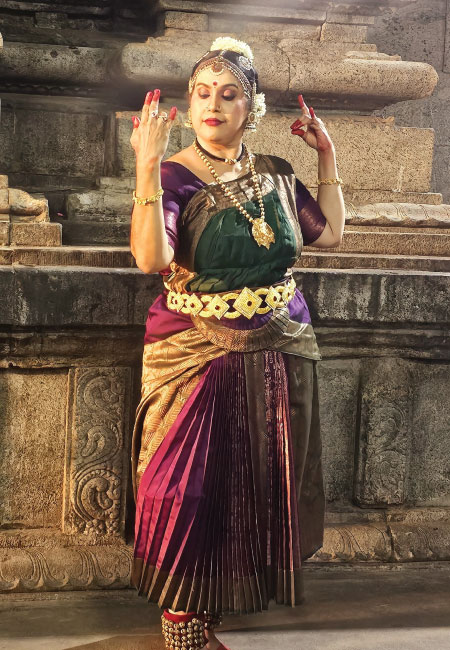
As the golden mornings of Kerala bathed the land in light, the rhythmic beat of nattuvangam echoed once again in Meena’s life—but now with sharper precision and deeper intensity. No longer just a gifted child dancing in divine abandon, Dr. Meena had become a disciple—not only of dance, but of discipline, of devotion, of a tradition passed down through centuries.
Her body had grown stronger, her limbs more supple, her expressions more nuanced. But more than that, her hunger for learning had become insatiable. The world of Bharatanatyam, once a vibrant garden she wandered through with innocent wonder, was now a sacred forest whose mysteries she was determined to explore, limb by limb, step by step.
At the tender age of four, Meena first stepped into the disciplined world of Bharatanatyam under the nurturing guidance of Guru Kalamandalam Chandrika. It was here, in the echoing rhythm of her first adavus, that she discovered the language of the body — a medium far more expressive than words. Chandrika introduced her to the sacred geometry of dance, where each posture was an offering, and each movement a prayer.
By the time she turned nine, Meena came under the care of Guru Kalamandalam Latha, who recognized not just talent but a spiritual resonance in her dancing. Latha nurtured that spark with immense patience and warmth, encouraging her to experiment with expression while remaining rooted in tradition. It was during this time that Meena’s identity as a dancer began to take shape — not merely as a student of steps, but as a seeker of something higher.
At thirteen, her path led her to Guru Kalamandalam Sathyavrathan, whose stern discipline and towering presence commanded respect. Under his rigorous mentorship, Meena refined her understanding of rhythm, structure, and form. He taught her that dance was not only an art but a discipline of the soul. Each gesture had to be precise, each talam a meditation. Sathyavrathan instilled in her the importance of structure — the sacred scaffolding upon which emotion and storytelling could safely unfold.
At eighteen, her journey progressed to the seasoned expertise of Guru Kalamandalam Vinodini, under whom Meena’s refinement and polish as a performer flourished. Vinodini guided her in mastering subtleties — the controlled energy in movement, the breath that precedes a gesture, the power of stillness. She also helped Meena evolve her stagecraft and understand the relationship between dancer, audience, and space.
Phase 3 : The Global Grace
“Dance is the hidden language of the soul.”
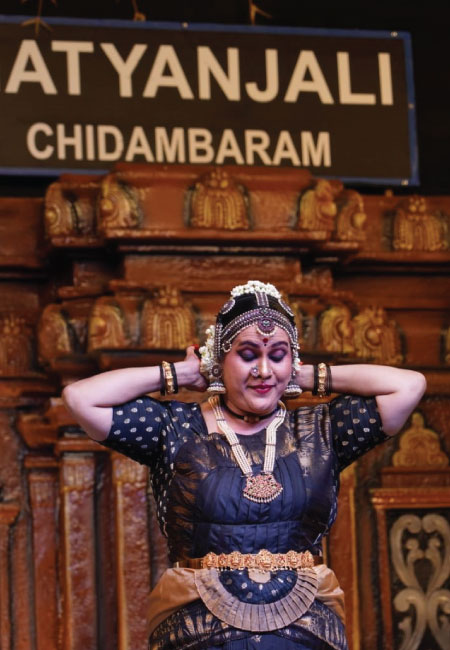
For most, marriage is a turning point—a shift in priorities, location, and lifestyle. For Dr. Meena, it was indeed a turning point, but not one of departure from her art. Rather, it was a catalyst for expansion. Her marriage transported her to unfamiliar geographies, where desert winds whispered a different rhythm, and skyscrapers cast their shadows over the echoes of tradition. Yet, even as the physical landscapes changed, the landscape of her soul remained rooted in the rhythms of Bharatanatyam.
Her journey began in Dubai, a city of futuristic ambition and multicultural vibrance. Amidst its modern skyline and cosmopolitan pulse, Dr. Meena carried with her an ancient rhythm, bound by silk sarees, jasmine flowers, and the echo of salangai (ankle bells). In a land where traditions often melted into the mirage of modernity, she stood as a beacon of classical authenticity.
Starting small, she began conducting workshops in local Indian community halls and cultural centers. Word spread quickly—this wasn’t just a dance teacher. This was an artist who embodied the sacredness of her tradition. Her classes were not mere rehearsals of steps; they were immersive experiences in devotion, discipline, and heritage. She invoked in her students a reverence for dance that transcended the performative—it became a path of inner awakening.
Soon, mothers began bringing their daughters to her with hope-filled eyes, and Dr. Meena received them with the humility of a true Guru. Under her guidance, the students not only learned Bharatanatyam but were also introduced to the stories of gods and goddesses, the values of dharma, and the spiritual significance of every gesture. Each class was a cultural revival, a reclaiming of identity far from home.
From Dubai, her journey took her to Qatar, a land rich in tradition yet rapidly embracing global influences. Here, too, Dr. Meena became a torchbearer of Indian classical dance, one who wove heritage into the lives of Indian expatriates while simultaneously sparking curiosity among locals and other cultures.
She began choreographing and staging full-length productions—Ramayana, Krishna Leela, Devi Mahatmyam, and other thematic dance dramas that brought Indian epics to life. Her productions were not just technically precise; they were emotionally transporting. Audiences—whether Indian, Arab, or Western—were moved, not merely entertained. Her ability to translate complex emotions and divine myths into universally understood expressions made her performances accessible and admired across boundaries.